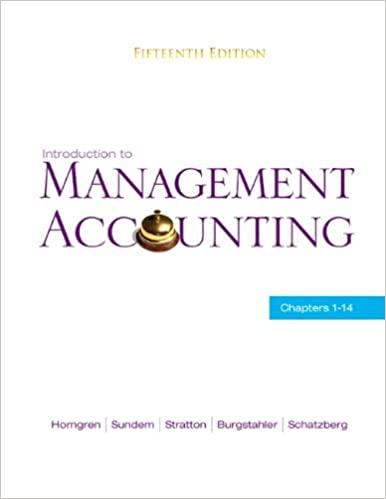Question
Problem 1: California Surplus Inc. qualifies to use the installment-sales method for tax purposes and sold an investment on an installment basis. The total gain
Problem 1:
| California Surplus Inc. qualifies to use the installment-sales method for tax purposes and sold an investment on an installment basis. The total gain of $75000 was reported for financial reporting purposes in the period of sale. The installment period is 3 years; one-third of the sale price is collected in 2014 and the rest in 2015 and 2016. The tax rate was 35% in 2014, 30% in 2015, and 30% in 2016. The enacted tax rates of 2015 and 2016 are not known until 2015. The accounting and tax data are shown below. |
| |||
|
|
|
|
|
|
|
|
| Financial Accounting | Tax Return |
|
| 2014 (35% tax rate) |
|
|
|
|
| Income before temporary difference |
| $ 175,000 | $ 175,000 |
|
| Temporary difference |
| $ 75,000 | $ 25,000 |
|
| Income |
| $ 250,000 | $ 200,000 |
|
|
|
|
|
|
|
| 2015 (30% tax rate) |
|
|
|
|
| Income before temporary difference |
| $ 200,000 | $ 200,000 |
|
| Temporary difference |
| $ - | $ 25,000 |
|
| Income |
| $ 200,000 | $ 225,000 |
|
|
|
|
|
|
|
| 2016 (30% tax rate) |
|
|
|
|
| Income before temporary difference |
| $ 180,000 | $ 180,000 |
|
| Temporary difference |
| $ - | $ 25,000 |
|
| Income |
| $ 180,000 | $ 205,000 |
|
|
|
|
|
|
|
| Required: |
|
|
|
|
|
|
|
|
|
|
|
| 1) | Prepare the journal entries to record the income tax expense, deferred income taxes, and the income taxes payable for 2014, 2015, and 2016. No deferred income taxes existed at the beginning of 2012. | ||
|
| 2) | Explain how the deferred taxes will appear on the balance sheet at the end of each year. (Assume Installment Accounts Receivable is classified as a current asset.) | ||
|
| 3) | Show the income tax expense section of the income statement for each year, beginning with Income before income taxes. | ||
Problem 1:
| California Surplus Inc. qualifies to use the installment-sales method for tax purposes and sold an investment on an installment basis. The total gain of $75000 was reported for financial reporting purposes in the period of sale. The installment period is 3 years; one-third of the sale price is collected in 2014 and the rest in 2015 and 2016. The tax rate was 35% in 2014, 30% in 2015, and 30% in 2016. The enacted tax rates of 2015 and 2016 are not known until 2015. The accounting and tax data are shown below. |
| |||
|
|
|
|
|
|
|
|
| Financial Accounting | Tax Return |
|
| 2014 (35% tax rate) |
|
|
|
|
| Income before temporary difference |
| $ 175,000 | $ 175,000 |
|
| Temporary difference |
| $ 75,000 | $ 25,000 |
|
| Income |
| $ 250,000 | $ 200,000 |
|
|
|
|
|
|
|
| 2015 (30% tax rate) |
|
|
|
|
| Income before temporary difference |
| $ 200,000 | $ 200,000 |
|
| Temporary difference |
| $ - | $ 25,000 |
|
| Income |
| $ 200,000 | $ 225,000 |
|
|
|
|
|
|
|
| 2016 (30% tax rate) |
|
|
|
|
| Income before temporary difference |
| $ 180,000 | $ 180,000 |
|
| Temporary difference |
| $ - | $ 25,000 |
|
| Income |
| $ 180,000 | $ 205,000 |
|
|
|
|
|
|
|
| Required: |
|
|
|
|
|
|
|
|
|
|
|
| 1) | Prepare the journal entries to record the income tax expense, deferred income taxes, and the income taxes payable for 2014, 2015, and 2016. No deferred income taxes existed at the beginning of 2012. | ||
|
| 2) | Explain how the deferred taxes will appear on the balance sheet at the end of each year. (Assume Installment Accounts Receivable is classified as a current asset.) | ||
|
| 3) | Show the income tax expense section of the income statement for each year, beginning with Income before income taxes. | ||
Step by Step Solution
There are 3 Steps involved in it
Step: 1

Get Instant Access to Expert-Tailored Solutions
See step-by-step solutions with expert insights and AI powered tools for academic success
Step: 2

Step: 3

Ace Your Homework with AI
Get the answers you need in no time with our AI-driven, step-by-step assistance
Get Started


